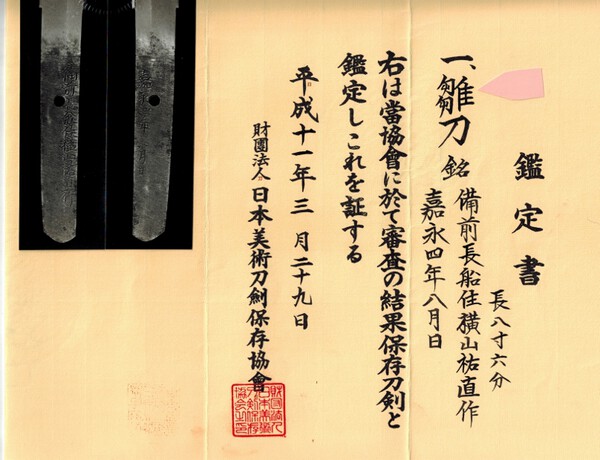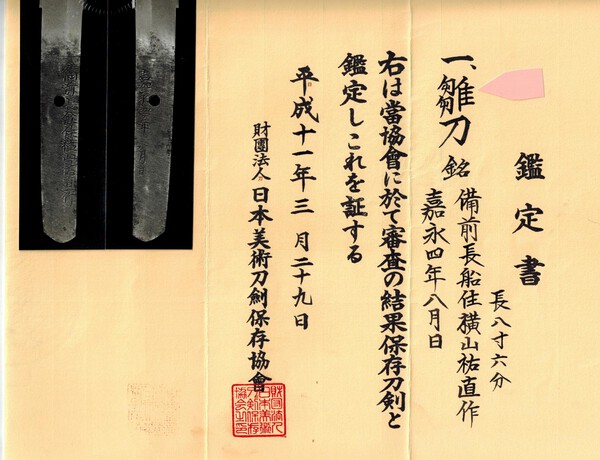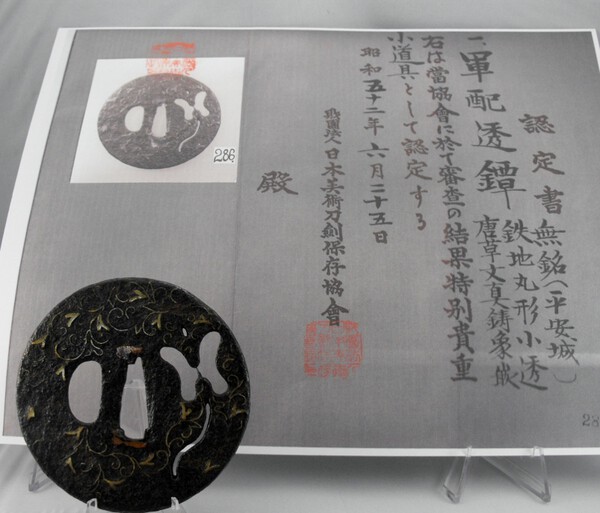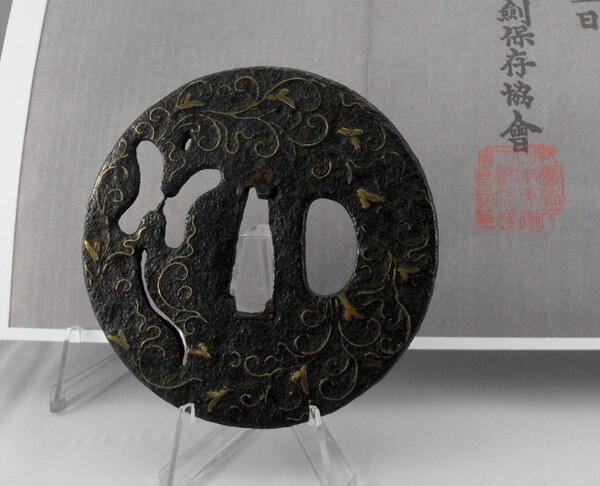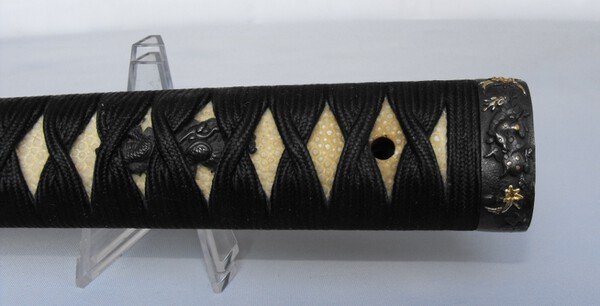-
Posts
26 -
Joined
-
Last visited
Everything posted by Chinook
-
-
Hello folks, Does anybody have any info on a a swordsmith that was active in 2005 that signs his swords ( Higo Kuni Ju Akasaka Tairyo Kanehiro ) ? There is a Redneck gun shop where I live that has a shinsakuto katana with this mei for sale. Thank you and good luck. Mark P.
-
Hello Folks, I am sorry it took me so long to reply, I would like to add some meaurements, a photo and a opinion or two. Hina Katana: OAL: about 38.5 cm Nagasa: 26cm Nakago length: 10.5 cm Nakago kasane @ the shinogi: 4.8mm to 3.1mm Nakago Haba: 18.4mm to 15.4 mm Weight: 145 gm. Now for comparison A tanto of mine. OAL length: 35.5cm Nagasa: 25cm Nakago Length: 10.6 cm Nakago kasane: 8.6mm to 5.1cm Nakago Haba: 22.6mm to 13.7mm Weight: 255 gm. Now please take note of the weight of both swords. The tanto is almost twice as heavy; Why is that? IMHO, the tanto was made for combat, not so for the hina katana , but then again the intended recipient was way to young for combat. Also it seems to me that the NBTHK put these little swords into thier own category so as not to me confused with other swords. Thanks for yor intrest. Mark Pederson.
-
Hello Folks, For your perusal I would like to present a Hina Katana newly added to my collection. I think of a Hina katana (sometimes referred to as a boys day sword) as I scaled down model of a standard sword; kind of like a model car or train. Thak you, Mark Pederson.
-
Thank You Guido,That was nice of you. Brian, I do not have any pictures yet, However , When I get some I will post a new thread. The sword is polished and mounted in a black ribbed togidashi-samezaya* . *(Markus Sesko) Thank You, Mark Pederson.
-
Hello and happy new year all. There is one kanji on this origami that I cannot figure out. It is the kanji below the Ichi and above the katana. Any help will be wecome. This is a boys sword. Thank you, Mark Pederson
-
-
Hello, Luca, your tsuba has the same characteristics as a tsuba I have. Mine is 81x81mm, iron with kage sukashi and brass hiza-zogan. the one I have came with Tokubetus Kicho Token with a attrabution to the Heianjo school. Some folks feel these were very early Heienjo. I will try to post some pictures, it's been a long time. I hope this helps. Mark P.
-
Hello folks, I will try to anwser some questions: I think that all of the fittings on this koshirae are machibori made in the late Edo period. I am not sure of the tsuba for it has papers of it's own attribution to "Akasaka". My reason for thinking that the kozuka is out of suite is becouse it has a theme of travelers in a boat with a nanko surface; whereas the F&K have a theme of grazing deer on a ishime surface. The whole thing just rings out iroiro-koshirae to me. I guess my next question is: Will the NTHK consider a koshirae as a suite with a misssing kozuka? Thank You and good luck. Mark P.
-
Hello Folks, I would like some opinions please. I wave a papered wakizashi and I am planning on submitting the koshirae for possibly kantei-sho. My question is I do not feel that the kozuga fits the suite; Should I just leave it out? I have had good luck in having two katana koshirae recieve kantei-sho in past years but neither of them even had a pocket for a kozuga, therefore it was not a issue. Thank you and good luck, Mark P.
-
Thanks guys for your help. I bought a book at the NCJSC sword show last August titled " Shinto Bengi Oshigata " by W. M. Hawley but it does not have a oshigata of the this smith and I could not find one online so your postings are a great help. Thanks and good luck, Mark P.
-
Hello, I am not having much luck on finding any info on the early Shinto swordsmith Yamato Daijo Fujiwara Masanori (nidai) . There is a lot out there on the shodai but I would like to compare would like to see a oshigata of the nidai masanori and learn more about him. Any help would be great. Thank You, Mark P.
-

In case you guys wonder why I over pack swords, fittings
Chinook replied to rkg's topic in General Nihonto Related Discussion
Hello all, You can never overpack IMO. It adds weight and cost more but overpacking can save a lot of heartache. If you have ever tried to get compensated for damage from any carrier for antiques that were damaged then you know how hard it is. I recently purchased a Wakizashi mounted in koshirae. When I received the package from the USPS it was ruptured and the saya had some slight damage. I submitted a insurance claim for $500. and they paid me; it was not easy and I had to play my cards just right. I have a Artist friend that use to make a successful living blowing art glass. He shipped his art using all of the USA carriers for many years and he has some real horror stories to tell. One more thing please; When shipping anything of value in the USA your best option is USPS Registered Mail. Thanks, Mark P. -
Stephen, I can see that a man of your talents could come in useful. If I could afford it I would like to light up San Francisco with you this August; It would be fun. Thanks for all the advise. I think I will bring cash, travelers checks and my paypal account. Thanks, Mark P.
-
Hello All, While attending a sword show what is a popular alternative for paying for a big ticket item other than cash? I do not really like the idea of walking around with four to seven thousand USD in my pocket. Thanks, Mark P.
-

Best five or so books for beginning Nihonto
Chinook replied to Sam Elliott's topic in General Nihonto Related Discussion
Hello Sam, I agree with Richard George. Nakahara's book is the best book in english you can buy. For me this book is about ten years to late. I have about worn my first one out. Sincerely, Mark P. -
Thank You Andreas B. for taking the time to post this info. I have a papered katana signed Sagami kami Fujiwara Hiroshinge and this info was very usefull for me also. For some reason I guessed the blade to be made around 1688 but now I know it is alittle bit older than that. Thanks again. Mark P.
-
Hello Curtis, I use that wax on everything except Japanese blades in art polish. Been using it for years on all my antiques, great stuff. By the way beware of Choji oil from unknown sources like e-bay, you never know what you are getting. Take care, Mark P.
-
The reason a ubu Shinto wakizashi is left unsigned is becouse it was meant to be unsigned. Unless a person was there at the time it was left unsigned to testify otherwise the blade should be reguarded with some uncertainty and that should reflect in the kantai-sho and the value. This is reasonable, unsigned blades should not be reguarded quite as high as signed blades. Thank You, Mark P.
-
Hello, I do believe there was a change in the nioi-guchi character during this era, it is just a matter of knowing what to look for. Mr. Nakahara writes that becouse of this change it would be better to situate the division between the Koto and Shinto works in the Kan'ei period rather than the generally regarded Keicho era. By the way this info can be read on pages 31 thru 36 in the book that I have. The problem I have is being able to view good swords in hand is rare. Besides the six swords a have to view I try to travel to San Francisco every August to attend the NCJSC show. Where I live Chain Saw Carving is considered fine Art. Thanks for the input . Mark P.
-
Have you ever read a book where the author touched on a topic but did not really go into any detail? Well in Nobuo Nakahara's book (Facts and Fundamentals of Japanese Swords) He makes statement that during the Kan'ei Era: (1624-1644) That the Koto-periods character of the nioi-guchi disappeared. Then goes on to state that this was the most significant point of that period. Now I have read that book many times and I have papered katana and Wakizashi from both the Koto and Shinto periods and I am at loss to see what he means by this statement. Can anybody shed some light on what he might have meant by this ? Thanks, Mark P.
-
Hello, John M. Yumoto states in his book ( The Samurai Sword) That smiths of the new sword period often used the Maru-gitae construction style when using imported steel. For a long time even before I started collecting and studying Nihonto I always took it for granted that Japanese swords were constructed with a core of softer steel. I guess it is one of those things that would be hard if not impossible to discern just by viewing the outside of the blade. I also read somewhere that smiths that tried nanban tetsu did not care for it all that much. Prehaps it was more of a experiment or a fad. Mark P.
-
Thanks Adam L. I sent you a PM stating why I think the sword is a product mass production. The reasoning being it is alittle off topic for this fourm. Take Care. Mark P.
-
Thanks for the info on the tsuba. What might not be apparent from the pictures is that the monkey entering the rocks is the same monkey coming thru the other side. There is actually a opening in the tsuba for the monkey to pass thru. Take Care, Mark P.
-
Thank You for all that took a look. The sword just got back from a NTHK-NPO Shinsa and the two character mei is that of a Mino-Seki,Tenbum era smith named Kanetsugu. It recieved 75 points, not to bad ,IMO, for what was probably a simi-massed produced blade. I just had to know for sure. I was going to send the tsuba to Shinsa but changed my mind. Thanks again. Mark P.







